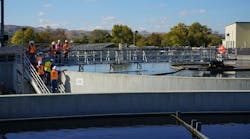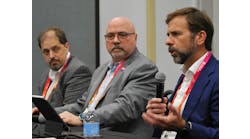Inland Empire wastewater plant expands and upgrades
How do you find, maintain and preserve water in the desert? Cooperation.
This was the most important strategy used by the seven municipalities in southwestern San Bernardino County, Calif., as they successively joined the Inland Empire Utility Agency (IEUA) after it was founded in 1950. They had to band together because water resources are so limited in southern California that its residents had to create IEUA as a special, independently elected district, which could import water from the state’s northern regions, and eventually collaborate on solving a variety of wastewater treatment issues to make them more efficient, too.
Thankfully, this collaborative spirit not only continues today, but is more important than ever in enabling IEUA to overcome sweeping and ongoing changes in its population, demographics, influent profile and the technologies it uses to fulfill its responsibilities.
“IEUA is unique compared to other utilities because we do it all, including importing water, wastewater treatment, recycling water, groundwater recharging, renewable energy generation, composting and other services,” said Alyson Piguee, external and government affairs director at IEUA. “However, IEUA relies on importing 30% of the water it consumes from California’s state water project, so we’re very dependent on local supplies, including recycled and groundwater, conservation, desalting, and recharging with stormwater capture and more recycling. We’re always seeking new ways to develop and store it.”
The utility’s staff provided a tour of their Chino headquarters and Regional Plant 5 (RP-5) upgrade presently under construction in conjunction with Automation Fair 2024 in nearby Anaheim.
Just the facts
The 243-square-mile district has 935,000 residents, and includes the cities of Chino, Chino Hills, Fontana, Montclair, Ontario, Upland and the Cucamonga Valley Water District. Its four other agencies representing customers are the Fontana and San Antonio water companies and the Monte Vista and West Valley water districts. IEUA typical performance includes:
- Importing more than 50,000 acre-feet (AF) of water annually in non-drought years;
- Using more than 1,200 direct connections to produce more than 34,000 AF of recycled water per year, or approximately 17% of the region’s water supply, though this water can only be used for irrigation, landscaping, industrial cooling, construction and groundwater recharging;
- Treating more than 51 million gallons of wastewater per day (mgd);
- Operating 19 groundwater recharging sites with 46 basins. During fiscal year 2023-24, IEUA recharged 13,851 AF of recycled water and 16,268 AF of stormwater and local runoff;
- Generating capacity of 6 megawatts (MW) of renewable energy, including 5 MW from solar and 1 MW from wind, which is accompanied by 4 MW of battery storage; and,
- Producing more than 230,000 cubic yards (cy) of compost per year.
IEUA’s five primary treatment facilities include:
- RP-1 in Ontario, which is its largest and treats up to 44 mgd;
- RP-2 solids plant in Chino that’s scheduled for decommissioning soon;
- RP-3 Carbon Canyon water recycling facility in Chino that can treat 11.4 mgd;
- RP-4 in Rancho Cucamonga that has a 1 MW wind turbine and houses the Inland Empire Regional Composting Authority’s (IERCA) facility that’s owned by IEUA and the Los Angeles County Sanitation District; and,
- RP-5 in Chino that presently serves 200,000 residents and will take over RP-2’s solids processing duties once RP-5’s upgrade is complete.
“RP-5 came online in 2003, while RP-2 started operations in the 1960s on land leased from the U.S. Army Corps of Engineers. This site is also located close to the Prado Dam’s spillway that the Corps is altering by 10 feet, which will put RP-2 in a 180-year floodplain,” added Brian Wilson, PE, principal engineer at IEUA. “Other changes driving the need for RP-5’s present revamp include the fact that land use in our service areas are transitioning from mainly dairy and agricultural to residential, commercial and industrial, which require more and stronger water treatment capabilities.”
Solids treatment revamps
However, for RP-5 to assume RP-2’s role, it is expanding its existing plant from 16.3 mgd to 22.5 mgd and building a new biosolids facility. Construction on the $330 million project began in 2021 and is expected to last another year and a half.
To further strengthen RP-5’s water treatment beyond expansion, Wilson added the revamp is also shifting part of its treatment process from traditional, gravity-based, secondary clarification and tertiary filtering to a membrane-bioreactor (MBR) process that’s more efficient. This will require adding some new influent pumps, debris screens, power centers, two primary clarifiers, new odor controls, and added channels and other modifications to its aeration basin.
More specifically, this will allow RP-5 to ramp up its treatment capability from 6,000 milligrams per liter (mg/L) concentration of solids to 8,000 mg/L. Likewise, it’s new solids dewatering and sludge processing applications are adding blowers, boilers, power centers, digesters and a solids-thickening building.
Keeping the lights out
Even though it’s expanding treatment volumes and adding solids processing tasks, IEUA also wants to maintain present staffing levels. Since 2006, process automation has allowed RP-5 and the utility’s other plants to be manned by humans for only 10 hours per day.
“Process automation needs continuous updating, including some devices at their end of life and others that are increasingly unsupported,” explained Wilson. “Either way, they have to be switched over.”
Loren Shipley, account manager for IEUA at Rockwell Automation, agreed, “RP-5’s legacy DCS (distributed control system) wasn’t supportable, didn’t provide enough training, and made the utility struggle to run lights out for 14 hours. Standardizing on our PlantPAx DCS, power solutions and ThinManager software on VMware virtual servers resolved these difficulties, while also allowing for future changes and expansion, and even adding artificial intelligence (AI) capabilities.”
Consequently, Wilson reports that RP-5’s additional process automation components include:
- 64 PLCs including ControlLogix for Process for an increase from 23 to 87;
- 105 variable-speed drives (VFD) for an increase from two to 107;
- 148 network switches for an increase from 16 to 164;
- 2,603 digital inputs for an increase from 1,632 to 4,235;
- 2,002 digital outputs for an increase from 187 to 2,189;
- 1,000 analog inputs for an increase from 456 to 1,456;
- 712 analog outputs for an increase from 88 to 800;
- 17 fiber-optic networks for an increase from 14 to 31;
- Six virtual machines (VM) for an increase from 70 to 76; and,
- 11 thin clients for an increase from five to 16.
“We’ve got 5,300 new pieces of equipment, such as pumps, valves, VFDs and air-conditioning units, but many others consist of panels that have 15-20 components inside,” explained Wilson. “We’re increasing instruments and other equipment by 200% each and increasing I/O and PLCs by 250% each. This is a lot more process unit intensity and facility complexity.”
This automation hardware and software helps RP-5 and IEUA maintain its 10-hour daily staffing program, even though many maintenance, service and cleaning tasks are still manual and must be performed directly onsite. Wilson reported that many users can receive alerts remotely, check chemical parameters, dial in to fix many problems, and even automate some on-off tasks.
Facilities in the field
While the control room at RP-5 focuses mainly on its own systems and equipment, it also helps monitor and manage water recycling operations at the RP-3 Carbon Canyon facility. Both employ Rockwell’s PlantPAx 4.6 DCS, and run four thin clients with ThinManager software behind 12 screens with grayscale graphics, which mostly handle the plant’s liquid operations. The plant’s three existing power centers employ Rockwell’s IntelliCenter CenterLine 2100 motor control centers (MCCs).
When RP-5 starts its new solids processes, Wilson reported they’ll be controlled by seven more thin clients on 12 more screens. The six new power centers energizing them will use another three thin clients on another dozen screens.
After a preliminary treatment process removes debris, two vast basins at RP-5 each use four rectangular, primary-treatment tanks to aerate the wastewater coming into the plant. They use bacteria to biologically oxidate the water, and convert ammonia into nitrites and then into nitrates. This aeration process continues in the familiar, cylindrical, secondary-treatment tanks that slowly agitate and clarify the water before it’s sent onward for tertiary filtering and disinfecting.
The two MBRs under construction at RP-5 will replace much of its traditional, secondary, aerating and clarifying with a new tertiary treatment method that uses finer, fiber-filtering screens, balances the bacteria’s environment for optimal performance, and reportedly produces 10 times higher quality effluent.
Meanwhile, the new solids area at RP-5 will take in wastewater at 6% solids; digest it at 100 °F; produce methane to power onsite boilers; release it at 2% solids; spin and dewater it until it’s 20-26% solids; and further process it into sludge that can be used for composting.
Duality for reliability
Thanks to IEUA’s duality policy, as many as half of RP-5’s new controls and components are held in reserve, so the overall system can maintain continuous reliability, and even perform upgrades without interrupting normal operations and expected performance levels. For example, the expanded plant will have 87 PLCs, but will usually only need to operate 43 or 44 for typical conditions. This duality strategy also relies on some redundant switches, servers and virtual servers running parallel redundancy protocol (PRP).
Cybersecurity is maintained via a virtual local area network (VLAN), firewalls and data diodes. The thin clients and Thin Manager also restrict unauthorized access, while Rockwell’s FactoryTalk Directory software performs authentication and authorization, and FactoryTalk Asset Centre software contributes similar functions.
“I think we’ve done about 100 tours for representatives of our other municipalities and service agencies, and for many other community members,” said Wilson. “One retired police chief said she never thought about where wastewater went before, but was glad to know it now.”








